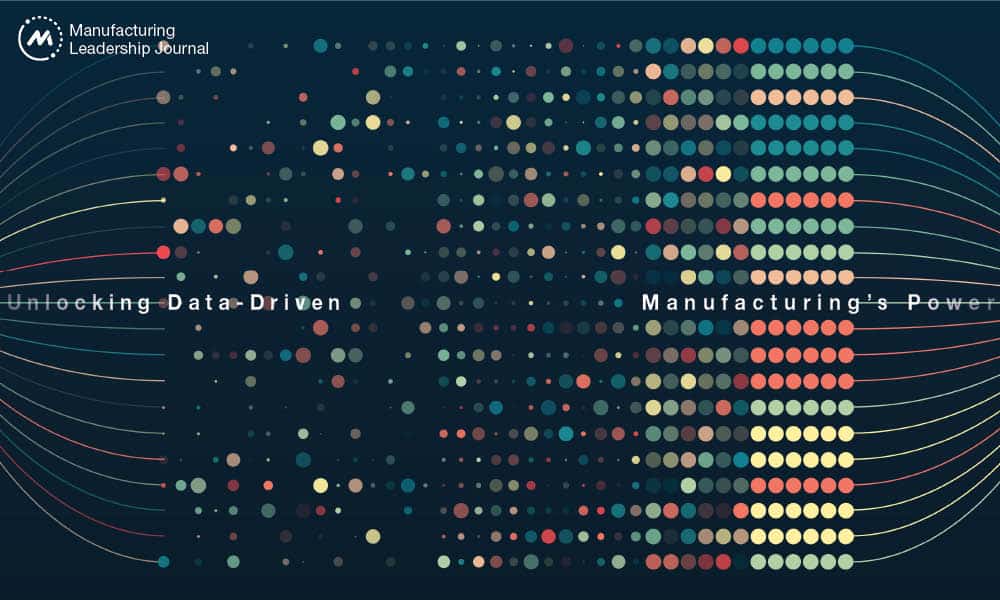Unlocking Data-Driven Manufacturing’s Power

The challenge of decoding and using data to drive strategic outcomes and unlock value

TAKEAWAYS:
● Data has the power to optimize and scale manufacturing operations, enable the workforce, and boost performance.
● Manufacturers have struggled to build a business model that captures data’s value and seamlessly integrates data into day-to-day functions.
● Organizations that empower workers to be part of their data transformation strategy can gain a competitive edge.
Effective use of data is increasingly important for manufacturing organizations. The EY CEO Imperative Survey revealed 70% of manufacturing sector respondents see digital innovation as a transformation driver for their companies.¹ However, few manufacturers have been able to successfully navigate this complicated domain. Many continue to struggle with connecting equipment, systems and factories. Others collect data lakes that require extensive effort to extract meaningful insights. Ongoing growth through acquisition has exacerbated the opportunity as global organizations often acquire companies at different stages of technological development. With disparate machines, systems, siloed architectures and data models, time is spent trying to capture and make sense of data rather than taking actions that drive business needs.
The need to effectively use data has never been greater – or more urgent. Ongoing global disruptions are driving more on-shoring and near-shoring of manufacturing in markets with higher-cost labor, which demand more productivity. At the same time, changing customer expectations and unreliable material sources are intensifying the need for agility. These challenges are compounded by ongoing labor and skills shortages that highlight the need to utilize, attract and retain talent by creating more engaging and impactful worker experiences.

“The need to effectively use data has never been greater – or more urgent”
Today’s market requires a data-driven manufacturing approach. The focus is on capturing the right data, modeling it for effective insights, and empowering workers with the information they need to optimize day-to-day operations. Additional priorities include, upskilling personnel, and enhancing work processes in ways that strengthen performance and boost value.
Leading with value
At its core, data-driven manufacturing is about leveraging business outcomes based upon intelligent data. The focus is on connecting and capturing data from the manufacturing floor to the enterprise layer, linking that data to unique business requirements and then identifying actionable insights that can improve overall business competencies.
Making the shift from a reactive to a proactive data-driven operation typically requires investment in connecting legacy equipment, mapping infrastructure, integrating systems, and developing end-to-end data and cloud strategy. Priority use cases will need to be defined and operating systems will likely need to be upgraded. This effort should be underpinned by well thought-out architecture, data management processes, and orchestrated change management processes. It is about managing data as a product, and supporting each role, function, and level on that individual’s personal journey map. All of this must also be connected to tangible business outcomes, not just KPI improvements.
Companies that are unable to link data and technology investments to business results often feel trapped in “pilot purgatory.” They are always searching for answers, but find it difficult to justify the additional investments needed to scale. Traditional operational excellence programs may yield improvements, but the lack of sufficient data and insights likely prevents these improvements from being fully sustained over time. Cost-control programs that have been in place for some time may see their benefits begin to plateau. The missing piece to maximizing these benefits could be data-driven insights.

“Companies that are unable to link data and technology investments to business results often feel trapped in ‘pilot purgatory’”
Being able to effectively identify, monitor and realize the value derived from intelligent data investment requires more than identifying costs and tracking KPIs. It starts with a fundamental shift in thinking that data-driven insights are essential to enabling the strategies that have already been laid out, and not as siloed IT, engineering or operations programs that compete for resources. Organizations must begin to connect the dots to see how these digital enablers create new capabilities that support better business outcomes, and how those business outcomes translate to achieving strategic business objectives.
EY recently worked with a global industrial products manufacturer that was struggling to justify infrastructure and system upgrades. These investments were necessary to capture and display real-time overall equipment effectiveness (OEE) visibility in and across their plants. However, business leaders were unable to see how it connected to a core strategic pillar of protecting market share in increasingly competitive markets. By developing a business case that linked the investments to a new enabler (OEE visibility), to new capabilities (proactive problem solving), to a business outcome (increasing labor productivity to offset increasing raw material prices), and to helping achieve the strategic objective (enabling prices to stay low to prevent competitors from taking market share), they were finally able to align on the importance of the program. As a result, the first pilot site was able to properly identify and categorize issues that had never been captured, which accounted for nearly 75% of all production losses. Now, they are systematically working on actions to eliminate these losses.
Navigating the application and data modeling landscape
Once there is alignment on data’s value potential, the complicated work begins to figure out how to collect the data and effectively use it. Organizations need to develop a strategy to capture data from brown or green field sites, interconnect siloed systems, develop end-to-end data and cloud and data management strategies, and develop new business workflows. It begins with a data readiness assessment for each facility, which is mapped across the standardized IT and OT architectures to gain visibility of the data readiness gaps. With advancements in edge, IoT, and OT cyber security solutions (which runs across all systems), data gaps can be bridged, and meaningful data can be extracted from different machines and systems. The data ingestion happens via IoT protocols (MQTT, API, OPC-UA, etc.) and traditional proprietary protocols, and is integrated with the organization’s IT enterprise layer.
With business use cases at the forefront, a modern technology data stack (data capture, ingestion, compute, and storage) and powerful ML/AI capabilities, intelligence can be extracted to demonstrate actionable insights. The data analytics and reporting can be visualized using modern business intelligence or the organization’s preferred tools. Cyber-security plays a huge role and is embedded across all levels of the architecture, ensuring proper authentication, and mitigating the risk of unnecessary data replication.

“Data-driven manufacturing provides those unique capabilities where data insights can happen at different layers of edge, cloud, or on-premises systems”
Data-driven manufacturing provides those unique capabilities where data insights can happen at different layers/stages of edge, cloud, or on-premises systems. The data can be processed in real-time, near-real-time or can follow a cold path route followed by ML/AI processing for insights, depending on the use case. Every customer’s data-driven initiatives are different. Comprehensive tools, advanced technologies and use case accelerators can be brought into the digital journey.
In another use case, EY recently worked with a global pharmaceutical manufacturer to assist in standing up their own connected analytics capabilities. The manufacturer built data pipelines to stand up a rapid proof-of-concept at a facility, deploying to end users with training and validation to enhance before scaling to the broader network. A focus on connectivity, data modeling and analytics enabled the manufacturer to provide the right information to the right people at the right time. All investments were supported by processes that required value to be planned and proven on a small scale before being rolled out enterprise-wide.
This led to a nearly 40% increase in product yield and a 60% reduction in unplanned production stops.
Keeping people at the center
Even with a solid business case and state-of-the-art technologies, real value and improvement lies in employees’ hands, hearts, and minds. It is critical to keep people at the center of all data-driven initiatives, and manufacturers must maintain focus on how new capabilities will upskill and enable workers at all levels. New research indicates that giving specific focus to a series of complex human factors can increase the probability of success to more than 70%.² Each member of the organization will play at least one role as a data generator, data analyzer, or data consumer. Depending on the employee’s function, responsibilities and roles, outlining the journey map of how these new data capabilities will impact them and including them in each step of the process will be critical for adoption and sustainment.

“Almost 60% of manufacturers surveyed by the NAM are creating or expanding internal training programs to address skills shortages through adaptive upskilling”
In a study by EY and The Manufacturing Institute, research showed industry leaders recognize that increasing business performance by asking more from their existing workforces is not enough.³ Seventy-four percent of leaders surveyed indicate that the skills needed for manufacturing jobs are changing rapidly and 82% shared they are seeking new and innovative ways to invest in the careers of their workforce. The study also found that almost 60% of manufacturers surveyed by the National Association of Manufacturers (NAM) are creating or expanding internal training programs to address skills shortages through adaptive upskilling. These adaptive skill programs are giving manufacturers new ways to educate and align their manufacturing operations to data-driven transformation journeys. The goal is to keep pace with the speed of innovation, create iterative value, and evolve based on the new insights that data provides to the organization.
Summary
Data is emerging as the strategic currency of the digital age. With rapidly growing demand for modernized manufacturing systems, companies can use data-driven problem solving to gain a competitive advantage that will expedite their digital transformation journey.⁴ Data is a critical component to inform an organization’s path and building an organization that can meet the market’s needs and expectations. It can help companies see their way through the challenges and complexities of doing business in today’s world. It can also provide a plan built around creating value, leveraging digital tools and engaging people at each step of the journey toward fulfilling the organization’s mission. M
Article references
1 Why industrial companies need to lead business model innovation, www.ey.com/en_us/advanced-manufacturing/why-industrial-companies-need-to-lead-business-model-innovation
2 The CIO Imperative: Is your technology moving fast enough to realize your ambitions? www.ey.com/en_us/consulting/tech-horizon-survey
3. How adaptive skills can play a pivotal role in building the manufacturing sector of the future, www.ey.com/en_us/advanced-manufacturing/the-manufacturing-institute-adaptive-skills-study
4. How do you harness the power of people to double transformation success? www.ey.com/en_gl/consulting/how-transformations-with-humans-at-the-center-can-double-your-success
About the authors:

Manan Bawa: Senior Manager, Technology Consulting, Data & Analytics, EY
Manan Bawa is part of the data and analytics team with a strong focus on the advanced manufacturing and mobility sectors. With a 13+ year career in managing key products and technical transformations, Bawa has delivered superior results for billion-dollar projects and high-profile organizations. He is a proven, versatile leader known to spearhead emerging technologies, develop sustainable and smart factories, and produce cost-effective deliverables within the advance manufacturing, power and utilities, energy, CPG, oil and gas, tech, retail, and mobility sectors.

Robert Calloway: Americas Manufacturing and Mobility Technology Leader, EY
Robert Calloway brings 33 years of experience to help organizations develop and execute digital transformation journeys that leverage data and technology to both optimize business operations and create value and growth.

Zakir Hussain: Partner, Americas Data Leader, EY
Zakir Hussain leads a best-in-industry team to deliver technology implementations for his clients across sectors. For more than two decades, Zakir’s clients have benefited from his team’s experience and expertise in technology and data modernizations – uniquely positioning each to advance and accelerate their growth initiatives.

Greg Wagner: Data-Driven Manufacturing Solution Leader, EY
Greg Wagner is a transformation leader at EY who specializes in implementing data-driven manufacturing capabilities with clients. He possesses a background in Lean Six Sigma and quality, asset reliability and integrity, operational risk management and digital manufacturing. Wagner has more than twenty years of consulting and industry experience working in leadership, operations and technical functions within the chemicals, oil and gas and specialty manufacturing industries.